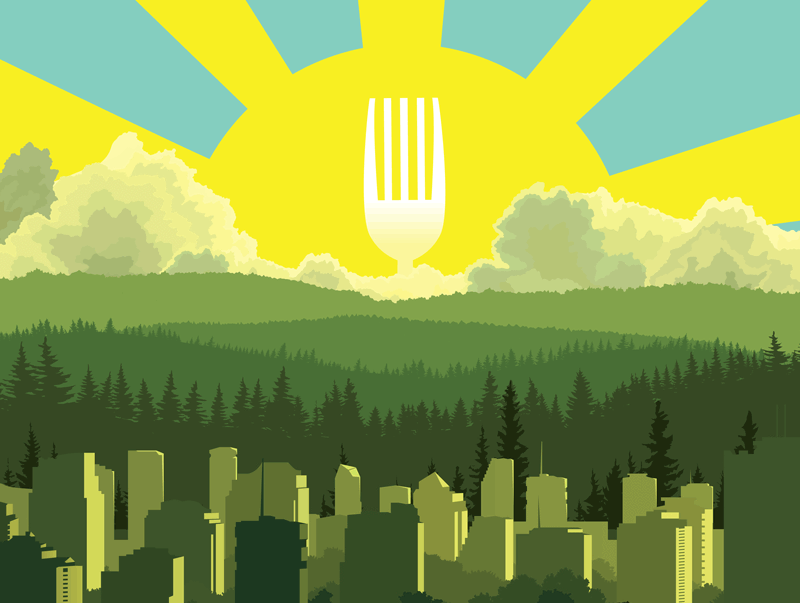Why Are Enterprising Portland Foodies Heading for the Suburbs?

When Ristorante Fratelli’s chef, Paul Klitsie, moved from Mount Tabor to Vancouver in 2002, that Washington city was not, let’s say, a dining destination. The ’Couv had its standbys, but those seeking grander meals crossed the Columbia. After watching this migration for more than a decade, Klitsie took action.
“There’s a saying in the Netherlands,” explained Klitsie, a native Dutchman. “‘When Muhammad doesn’t come to the mountain, then the mountain will come to Muhammad.’”
About a year ago, he opened Willem’s on Main, a 49-seat restaurant serving Northwest-influenced pastas, pork loin, rockfish, and rib eye, in downtown Vancouver. Within five weeks, Willem’s had expanded its hours to meet demand. In April, Klitsie introduced an entirely Vancouver-sourced weekend brunch menu, meaning the restaurant now opens every day. He also shuttered Fratelli, his 15-year-old Italian restaurant in Pearl District, to concentrate on his Vancouver venture.
Trading prime urban territory for a suburban outpost might seem counterintuitive. But Klitsie sees untapped opportunity north of the Columbia.
“The Pearl District had evolved tremendously since Fratelli opened, and it was time to move on,” Klitsie says. “Even though Vancouver is only six miles from the Pearl, it is a different world. Brunch on Saturdays is something that Vancouver is slowly starting to discover, whereas people wait in line for hours in Portland.”
He is not alone among urban-inflected culinary pioneers beyond city limits, drawn by surging demand and cheap space. “There is a push-pull,” says Charles Heying, an associate professor of urban studies at Portland State University. “The push is that the urban market may be getting saturated. And there are a lot of educated, well-paid professionals in the suburbs. That’s the pull. ”
Among early adopters, enthusiasm runs high. After debuting in central Portland’s celebrated food cart scene, Koi Fusion owner and Tigard native Bo Kwon brought his expanding fleet of Korean taco trucks to his hometown’s Bridgeport Village back in 2011. He then expanded to Lake Oswego, Beaverton, Hillsboro, and Washing-ton Square.
“It’s a totally different demographic, and that’s what I like so much,” Kwon says. “It might scare some people. You get into food to do what you want to do. When you go to a spot like Bridgeport, they want things their way. In the central city, if you make a good product, people will wait 30 minutes for it. They’ll eat it on the side of the street. In Bridgeport, it doesn’t matter if you make the best burrito if you can’t make it in five minutes, because they’re on a 30-minute lunch. You have to understand that you’re going into a different ballgame. You’re going to have to play by their rules, but your food will still be your food.”
When Linda Shankweiler, former design director of Mix, the Oregonian’s now-defunct food magazine, opened Pronto Pizza in a Clackamas strip mall early last year, she pledged to use seasonal ingredients from local farms. The strategy threw many locals. “We’ve had customers say, ‘I don’t care about organic,’” says Shankweiler.
On the other hand, Pronto’s monthly rent is $0.77 per square foot. In inner Southeast Portland, its footprint might cost more than twice as much. In Clackamas, Pronto can afford a playroom where retro cartoons play. Parking is plentiful and free.
Portland’s edges show promise in other areas as well. The percentage of Clackamas County adults with bachelor’s degrees—often a proxy for the market for organic or specialty foods—has risen steadily at a rate of around 3 to 5 points per decade. Current US Census data put the figure at 31.8 percent, 2.6 points above the Oregon average. Washington and Clark Counties have also exploded in recent years—
their populations have more than doubled since 1980, and have grown 25 percent since 2000.
“The suburbs are due for a renaissance,” says Heying. “I could see hipster chefs thinking, ‘Hey, rents are not bad, competition in my niche is very low, hanging out in the burbs is sort of pioneering-retro, let’s go for it.’”
Paul Klitsie offers a longer-term perspective. “There’s definitely a culture in the suburbs to get large amounts of food with not a lot of quality,” he says. “But to be honest, 15 years ago, that was Portland, too.” Today’s Vancouver, he says, reminds him of the Pearl District circa 2004, when the Portland food-culture groundswell was just beginning to coalesce. “I would like to really lift the area to a higher level,” Klitsie says of his new scene. “Do I want to go to Portland, or do I want to go where I live?”




